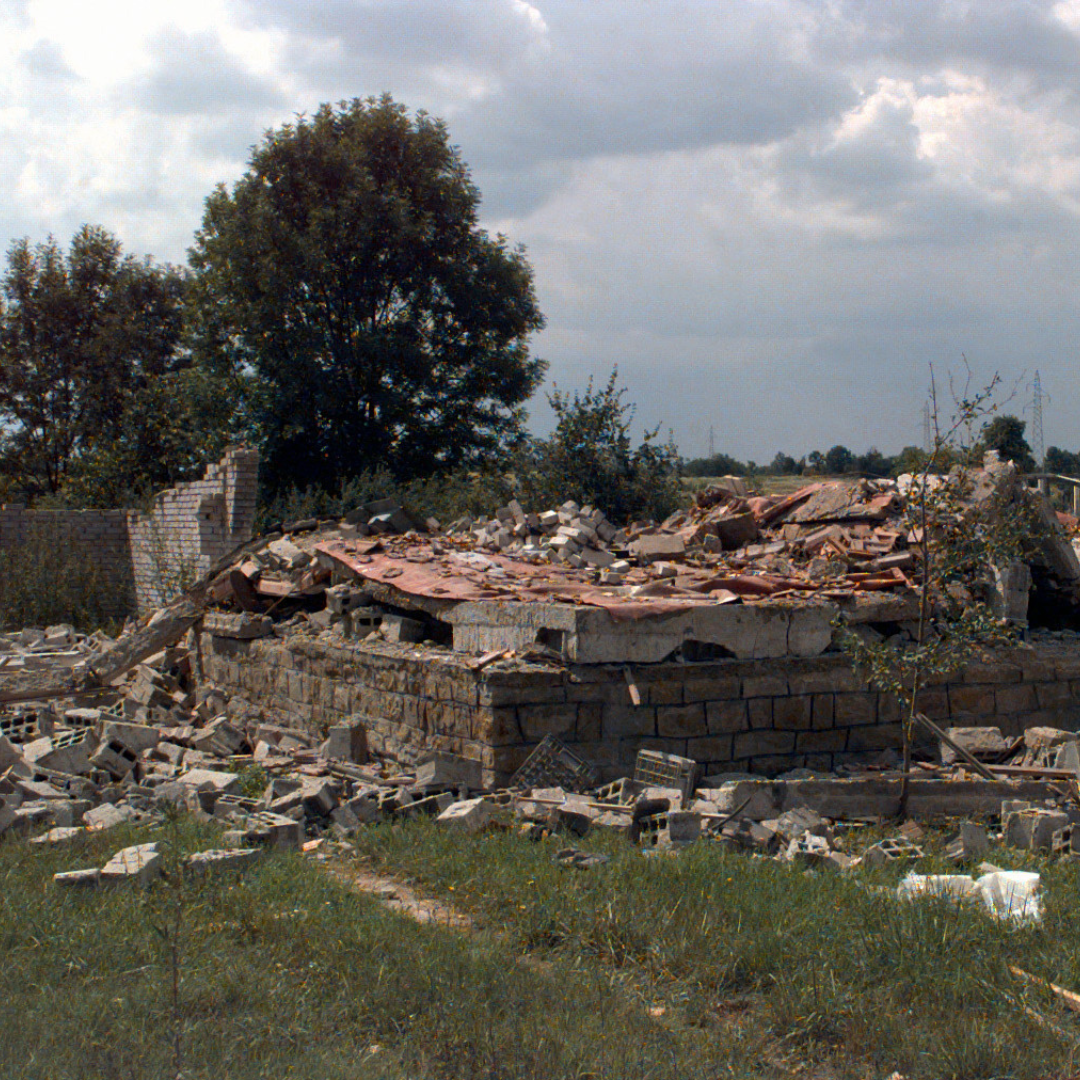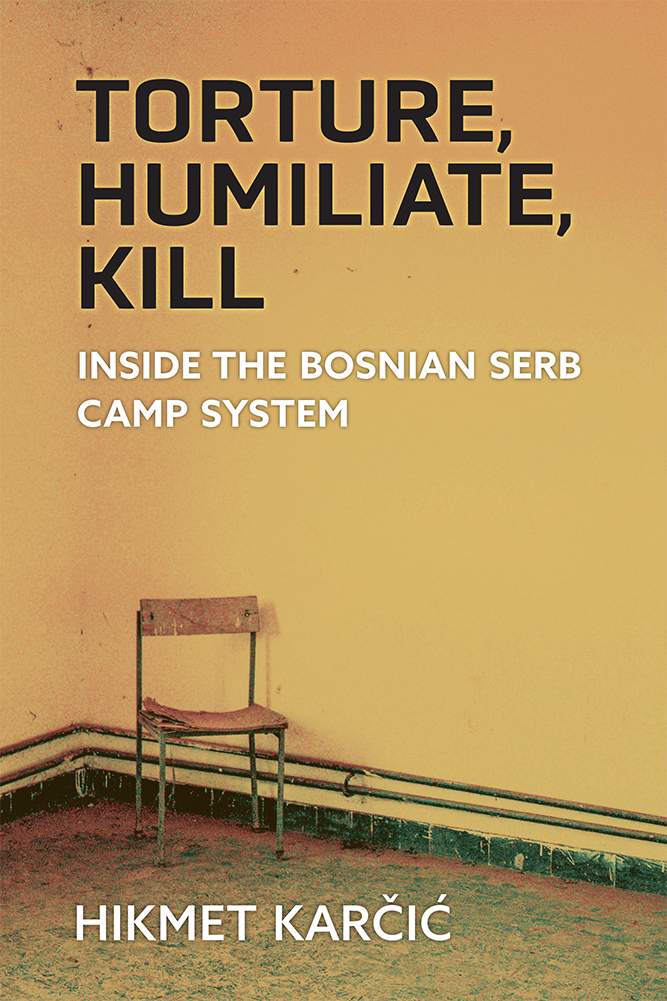The brutal world of detention centres in Bosnia and Herzegovina
 A Muslim house that was destroyed by Serbian Militants near the town of Brcko, July 1996. Photo credit: US National Archvies/NAI 6596576.
A Muslim house that was destroyed by Serbian Militants near the town of Brcko, July 1996. Photo credit: US National Archvies/NAI 6596576. 
Published by: University of Michigan Press
 A Muslim house that was destroyed by Serbian Militants near the town of Brcko, July 1996. Photo credit: US National Archvies/NAI 6596576.
A Muslim house that was destroyed by Serbian Militants near the town of Brcko, July 1996. Photo credit: US National Archvies/NAI 6596576. Hikmet Karćić’s haunting study of the Bosnian Serb camp system analyzes the brutal and secretive world of detention centers in Bosnia and Herzegovina in the early 1990s. It reveals how perpetrators exploited the international community’s legal underpinning of the right to national defense and security to legitimize genocidal campaigns. It also exposes the intentional uses of trauma to silence and erase survivor voices, both at the time and in historical writing.
The analysis and documentation of the internal dynamics of prison camps, detention centers, and concentration camps pose complex problems for any researcher. By their nature, such spaces are often designed to be concealed from or misrepresented in the public eye. Sources are deliberately scant. Public accounts are censored. Survivors are intentionally traumatized or threatened into silence. Overseeing governing bodies have a vested interest in concealing lists of their prisoners and the scope of their activities. Foreign statesmen and journalists are often provided with carefully constructed stories of what goes on behind prison doors and barbed wire. Perpetrators come up with obscuring language to describe the people detained and the places that imprison them. The incarcerated are terrorists, traitors, extremists, and enemies; their prisons are detention centers or re-education centers.
Everywhere, discourses of law, legality, and national security are politically deployed to make it difficult to differentiate between valid state action and a crime against humanity.
Variations on this theme have been repeated over and over throughout the twentieth century, from the infamous examples of Nazi concentration camps and Communist gulags to more recent accounts of the U.S. prison at Guantanamo, Chinese detention centers in Xiangyang province, the camp system in Assad’s Syria. Everywhere, discourses of law, legality, and national security are politically deployed to make it difficult to differentiate between valid state action and a crime against humanity.
The study of camps and detention centers has flourished in the past decade despite these obstacles. Teams of researchers have dedicated years of painstaking collaborative work to reconstruct these histories, as evinced by the Encyclopedia of Camps and Ghettos, 1933-1945, the United States Holocaust Memorial Museum’s groundbreaking volume on the Nazi camp system. Killing Architects’ project on the Chinese detention camps of Uyghurs, recently featured at the Venice Architecture Biennale, brought together an architect, journalist, and computer programmer who combined methodologies of satellite imagery, interviews of survivors, and digital tools to map the landscape and interior worlds of detention camps in China, where millions of Uyghurs have disappeared. Syrian Gulag: Inside Assad’s Prison System drew on expertise in human rights and historical analysis to investigate how to research collective imprisonment designed to be misrepresented in the public eye.
Joining these influential studies, genocide scholar Hikmet Karčić introduces a scaffold and interpretive framework for examining the hundreds of detention centers, prisons, transit camps, and concentration camps built by Bosnian Serbs in the early 1990s, during the war in Bosnia and Herzegovina—which he coins the “Bosnian Serb camp system.” Carefully piecing together witness testimonies and Bosnian court records with historical expert witness testimony, cross-examinations of defendants, and other court reports amassed by the International Tribunal Court at the Hague and other international courts, Karčić draws on legal and historical tools, to trace the evolution of camps from May 1992 until the last prisoner exchanges in April 1996. The book especially focuses on 1992, detailing the founding moment when the camp system was created.
The Yugoslav state unraveled in the early 1990s with the serial secession of individual republics. In 1991, Slovenia and Croatia declared their independence. The Yugoslav Federal Army waged a last-ditch effort to keep the country together; war in Slovenia ended after ten days, while war in Croatia continued for several years. Meanwhile, different constituencies in Bosnia and Herzegovina, the most diverse of the republics, discussed their political future, with a majority of the population favoring Bosnian independence. That majority, however, fell largely (though not exclusively) along ethno-religious lines: Bosniaks (Bosnian Muslims) and Bosnian Croats overwhelmingly supported independence from Yugoslavia, while Bosnian Serbs rejected it.
Early detention centers were often created locally and spontaneously, using whatever spaces local police and politicians could gain access to, such as schools, military barracks, fire stations, hotels, police stations, or agricultural farms.
Bosnian Serbs understood themselves to be the legitimate and legal leadership of an existing governing apparatus and viewed those who supported independence as rebels, traitors, and enemies – that is, as an internal security threat. Following a March 1992 independence referendum that they had boycotted as illegitimate, Bosnian Serbs began detaining predominantly Bosniak (Bosnian Muslim) and Bosnian Croat (Catholic) men, notably those who refused to fight in the Yugoslav army, join the Bosnian Serb run government, or held positions of power. Early detention centers were often created locally and spontaneously, using whatever spaces local police and politicians could gain access to, such as schools, military barracks, fire stations, hotels, police stations, or agricultural farms. They were allegedly designed for “prisoners of war,” an ambiguous category of shifting meaning. The list of detainees gradually expanded to include large numbers of civilians – women, men, children, elderly – who came from communities that supported independence. Bosnian Serbs relied heavily on reserve and local police forces because unlike formal armies, they were not internationally regulated. They also created new extrajudicial governing institutions, such as the Prijedor Crisis Committee, which worked in tandem with municipal governments to oversee the consolidation of Bosnian Serb power and the discrimination, intimidation, and detention of populations deemed a threat.
Law became a central tool of legitimacy throughout the process of redefining citizenship, belonging, and rights claims. Dispossession of property, prohibitions on internal and foreign travel, employment restrictions, and internment all went hand in hand in a new construct of Bosnian Serb legality that removed people from the protections of the law. The same camp administrators who oversaw a system in which any civilian, whether eighteen years old or sixty, could be imprisoned as a national security threat, sought to represent the war as just war on an international stage. That required making the threat credible, in effect framing all violence as part of a civil conflict. This was especially the case as the Bosnian Serb local governments introduced other policies that targeted pro-independence communities. Men who refused to fight in the Bosnian Serb army were perhaps among the easiest to classify as traitors and a “security threat.” But the logic was harder to develop for other civilian populations. In the case of Bosniaks (Bosnian Muslims), who are the focus of Karčić’s study, the project of legitimacy was rooted in European histories of Islamophobia. The Bosnian Serb government emphasized that a perilous “Islamic threat” needed to be eradicated both for their own safety and also that of Europe. This framing of Islam and Muslims as alien required multiple erasures. It swept away the personal and community histories of individual people, local networks, historical leadership structures, Islamic buildings, and the practices of Islam.
Karčić moves between the organization, structures, and logistics of the camps and haunting accounts of torture, rape, starvation, and murder that occurred within them. There was an intimacy of violence that is central to his argument about trauma. The witnesses, victims, and perpetrators often knew one another. Karčić unearths accounts of people who trusted their attackers – a former neighbor, a teacher, a co-worker—only to be tortured and humiliated by them. The intimacy of knowing one’s assailant was, Karčić contends, part of the point. Such personal relationships amplify experiences of trauma and humiliation, both in the moment, and in the aftermath, especially when “the survivors, as well as the perpetrators, are still alive and mostly live in the same country, sometimes even the same town, even the same street.” (p. 3). The book calls on historians to situate multi-generational trauma in the specificities of the crimes.
In a deliberate, and perhaps controversial, intervention for studies of mass violence and genocide, Karčić systematically names both the victims and the perpetrators.
Karčić argues that murder was a part, but not the primary goal of the Bosnian Serb camp system. Instead, he argues that the objective was to traumatize, humiliate, and stigmatize non-Serbs so they would choose to leave. This “collective traumatization,” he argues, was a form of “psychological warfare” that was “in and of itself genocidal” (pp. 6-8). To develop this argument, he closely examines a multitude of camps in four towns in different parts of the country. This allows him to deploy a microhistorical approach that analyzes discrete local contexts, while also teasing out patterns across different camps that illuminate the centrality of trauma and humiliation. The treatment of different camps is uneven in length and structure; some sections rely heavily on survivor testimony, others on documentary records. Throughout these chapters, we are reminded again and again of the difficulty of uncovering the history of places meant to be hidden at the time and forgotten in the aftermath. The dead, of course, cannot speak.
In a deliberate, and perhaps controversial, intervention for studies of mass violence and genocide, Karčić systematically names both the victims and the perpetrators. In so doing, he argues, scholars can take an important step to counter genocide: “the names of those killed that fill…[the book]…were supposed to be erased forever – that is the point of genocide – but here their tragic stories are shared, and the memory of what happened to them, and who did it, are preserved.” (p. 5) Such erasure has been compounded in Bosnia and Herzegovina by the collective denial of victim experiences in the past two decades both among Bosnian Serbs and also within the international community. Large numbers of Bosnian Serbs, including elected officials, refuse to accept the verdict of genocide at the international tribunal or the legitimacy of certain claims of war crimes. Many people continue to understand the detentions as part of a lawful process of defense, seeing offenses that occurred within these camps not as war crimes, but as part of a brutal multi-sided civil conflict in which all sides committed crimes, and all bear some responsibility.
Such arguments are hardly unique to Bosnia and Herzegovina. Across the world, we find arguments in favor of national defense, “lawful” or “unlawful” detainment, and sovereignty deployed to legitimize crimes against humanity and extra-judicial activity within camps, prisons, and detention centers. Hikmet Karčić calls on us to scrutinize the language and experiences within the camps themselves, and to think about whether those who embark on such actions deserve to have sovereignty at all.
Emily Greble is the Nelson O. Tyrone Jr Chair in History and Professor of History and East European Studies at Vanderbilt University in Nashville, TN. An historian of the Balkans, she is the author of Muslims and the Making of Modern Europe (Oxford, 2021) and Sarajevo, 1941-1945: Muslims, Christians, and Jews in Hitler’s Europe (Cornell, 2011).

Torture, Humiliate, Kill: Inside the Bosnian Serb Camp System
Published by: University of Michigan Press
